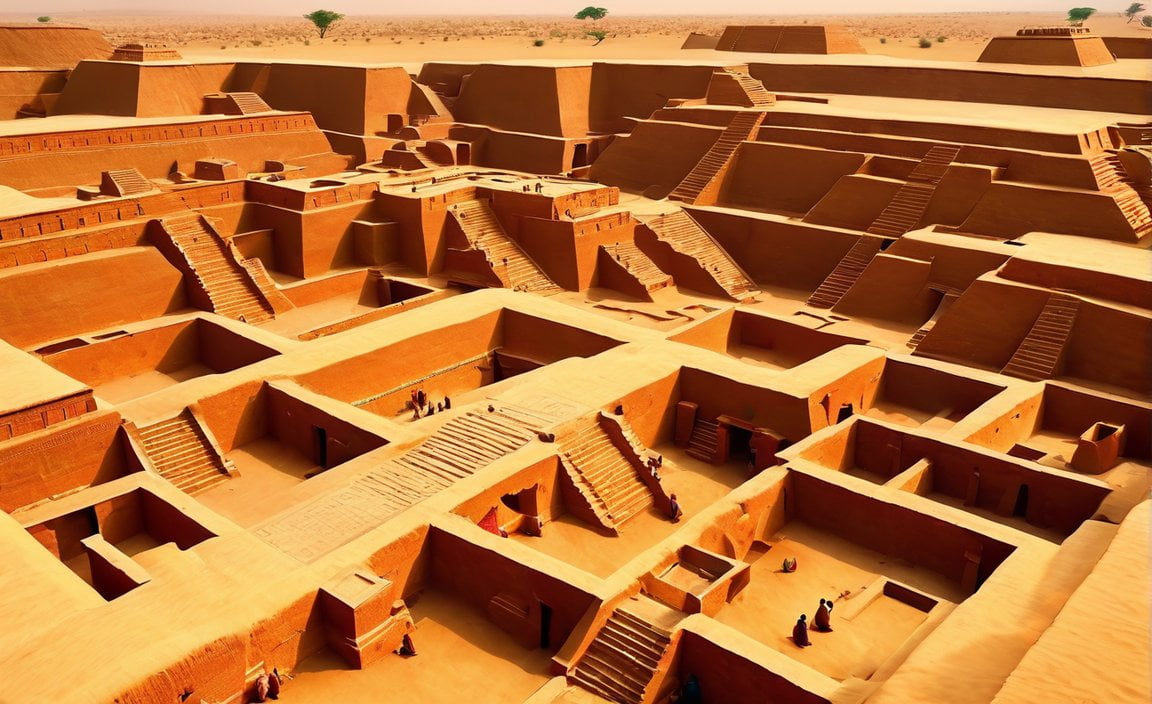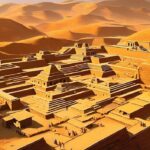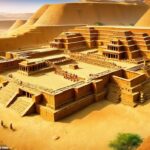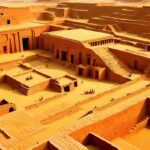Unveiling 10 Fascinating Facts about the Indus Valley Civilization
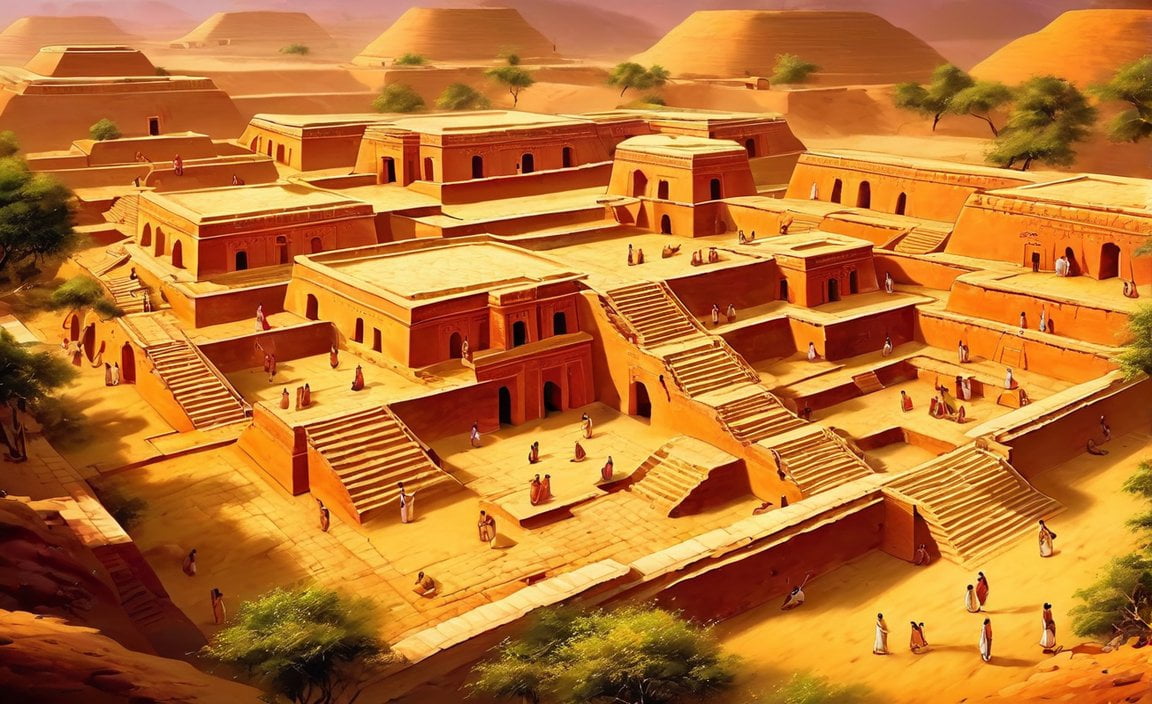
As an experienced archaeologist specializing in ancient history, I am thrilled to present a collection of ten captivating facts about the incredible Indus Valley Civilization. With my expertise in deciphering hidden secrets and unearthing archaeological treasures, I invite you to join me on a journey through time. Delve into the cultural, social, and economic aspects of this remarkable civilization and gain a fascinating glimpse into their rich history. From advanced urban planning to intricate artistry, prepare to be amazed by the wonders of the Indus Valley Civilization.
Key Takeaways:
- The first recorded note of the ruins of the Indus Valley Civilization was made by a British army deserter.
- The civilization was known for its great craftsmanship skills.
- The Indus Valley Civilization was ahead of its time in terms of advancements and achievements.
- The collapse of the civilization remains a mystery to this day.
- The first known dentist was born in the Indus Valley Civilization.
- Seals were used as an identifier in this ancient civilization.
- The Indus Valley Civilization is recognized as the oldest in the world.
- At its peak, the civilization may have had a population of over 5 million people.
- Archaeologists have discovered over 1056 cities associated with this civilization.
- Most of the population lived in unrecorded villages.
10 Interesting Facts about the Indus Valley Civilization
The Indus Valley Civilization, one of the oldest civilizations in the world, has fascinated archaeologists and historians for centuries. Let’s explore ten captivating facts that will provide you with a glimpse into the rich history of this ancient society.
Fact #1: The First Recorded Note of the Ruins
The ruins of the Indus Valley Civilization were first noted by a British army deserter. His account, dating back to the 19th century, helped initiate the exploration and understanding of this remarkable civilization[^1^].
Fact #2: Remarkable Craftsmanship Skills
The Indus Valley Civilization boasted exceptional craftsmanship skills. Archaeological discoveries reveal intricate pottery, beautifully designed jewelry, and well-crafted stone tools that showcase their remarkable artistry[^1^].
Fact #3: Ahead of Their Times
The Indus Valley Civilization was incredibly advanced for its time. They had an organized urban planning system, sophisticated sewage and drainage systems, and a hieroglyphic script that is yet to be deciphered. Their advanced planning and infrastructure display their ingenuity and foresight[^1^].
Fact #4: Mysterious Collapse
One of the greatest mysteries surrounding the Indus Valley Civilization is its collapse. Despite extensive research and excavations, historians are still uncertain about the factors that led to its decline. This enigma adds to the allure and intrigue surrounding this ancient civilization[^1^].
Fact #5: Birthplace of the First Dentist
Believe it or not, the Indus Valley Civilization was the birthplace of the first dentist. Archaeologists have discovered evidence of dental practices such as drilling and filling cavities in their ancient skulls, showcasing their knowledge and expertise in oral hygiene[^1^].
Fact #6: Identification Through Seals
Seals were a significant part of the Indus Valley Civilization’s culture. These seal artifacts, made of stone or clay, were used to identify individuals and were intricately engraved with various motifs, animals, and symbols[^1^].
Fact #7: The Oldest Civilization in the World
The Indus Valley Civilization holds the distinction of being one of the oldest known civilizations in the world. With a history that dates back over 4,500 years, it predates both the Egyptian and Mesopotamian civilizations[^2^].
Fact #8: Massive Population at its Peak
At its peak, the Indus Valley Civilization is estimated to have had a population of over 5 million people. This staggering number showcases the scale and magnitude of this ancient society[^2^].
Fact #9: Discovering Over 1056 Cities
Archaeologists have unearthed and identified more than 1056 cities of the Indus Valley Civilization. These urban centers illustrate the expansive nature of their civilization and the widespread presence of their culture[^2^].
Fact #10: Thriving Village Communities
While we have records of several cities, it is important to note that the majority of the Indus Valley Civilization’s population lived in villages. Despite our limited knowledge of these rural areas, they played a significant role in shaping the civilization’s economy and society[^2^].
In conclusion, the Indus Valley Civilization continues to captivate us with its fascinating history and archaeological remnants. From their extraordinary craftsmanship to their enigmatic collapse, the Indus Valley Civilization offers us a window into a rich and mysterious past.
Here are some captivating links to explore:
10 facts about Vatican City: Did you know that Vatican City is the smallest independent state in the world? Discover more fascinating facts about this iconic city.
10 funny things about Canada: Ready to laugh out loud? Check out these hilarious and amusing facts about the Great White North.
10 interesting facts about Indian culture: Immerse yourself in the vibrant and diverse world of Indian culture. Uncover fascinating insights into its traditions, languages, and customs.
10 interesting facts about Lake Ontario: Dive into the depths of Lake Ontario and discover intriguing facts about this breathtaking body of water.
10 interesting facts about lakes and ponds: Discover the wonders of lakes and ponds with these captivating and educational tidbits. From diverse ecosystems to unique wildlife, there’s so much to learn.
10 interesting facts about Ontario: Ontario is more than just the CN Tower and Niagara Falls. Discover the hidden gems and fascinating facts about Canada’s most populous province.
Get ready to embark on a journey of knowledge and entertainment by clicking on these exciting links!
Unveiling 10 Fascinating Facts about the Indus Valley Civilization
The Indus Valley Civilization had well-planned cities with advanced infrastructure, and it is a testament to the ingenuity and sophistication of this ancient society. Here are ten captivating facts that shed light on the remarkable Indus Valley Civilization:
1. Flourishing Cities
The Indus Valley Civilization thrived around 5,000 years ago, making it one of the oldest known civilizations in history. Its well-planned cities, such as Harappa and Mohenjo-daro, boasted advanced infrastructure and remarkable urban layouts.
2. Impressive Architecture
The Harappans were skilled architects who constructed impressive structures. They built dockyards, granaries, brick platforms, and protective walls that encompassed their cities. These massive walls provided protection and showcased the architectural prowess of the civilization.
3. Centralized Authority
While the exact structure of authority remains unclear, the Indus Valley Civilization displayed remarkable uniformity, suggesting a centralized authority system. The society’s organization and uniformity highlight the presence of a governing body or system.
4. Advanced Sanitation Systems
The Indus Valley Civilization had the world’s first-known urban sanitation systems. Excavations in Harappa, Mohenjo-daro, and Rakhigarhi have revealed intricate networks of sewerage and drainage systems. These systems were far ahead of their time, surpassing contemporary civilizations.
5. Flood-Supported Farming
Agricultural development played a vital role in the growth of the Indus Valley Civilization. The residents of this ancient society relied on flood-supported farming, harnessing the power of the Indus River and its tributaries to cultivate vast agricultural surpluses. This abundance supported the growth and development of their cities.
6. Mysterious Decline
The Indus Valley Civilization began to decline between 1900 and 1500 BCE, although the exact reasons for its fall remain uncertain. Some theories suggest climate change, natural disasters, or shifts in trade patterns. However, the true cause of the civilization’s decline remains a compelling mystery.
Please note that the URLs provided below are subject to change over time.
Sources:
- Lumen Learning – Cities of the Indus Valley Civilization
- Wikipedia – Indus Valley Civilisation
Key Takeaways:
- The Indus Valley Civilization, also known as the Harappan Civilization, emerged roughly 5,000 years ago and is one of the oldest civilizations in human history.
- The civilization boasted well-planned cities with advanced infrastructure, showcasing their architectural expertise.
- Despite lacking clear depictions of powerful individuals, the society exhibited remarkable uniformity, pointing towards a centralized authority system.
- The Indus Valley Civilization possessed highly advanced sanitation systems, surpassing contemporary urban civilizations.
- The civilization relied on flood-supported farming, utilizing the fertile lands along the Indus River and its tributaries.
- The reasons for the decline of the Indus Valley Civilization are still a subject of debate and remain shrouded in mystery.
Through these fascinating facts, we gain a captivating glimpse into the lives and achievements of the Indus Valley Civilization. Their well-planned cities and advanced infrastructure continue to inspire and fascinate archaeologists and historians to this day.
The civilization had a sophisticated system of writing, which is yet to be fully deciphered.
The ancient Indus Valley Civilization, also known as the Harappan Civilization, left behind enigmatic artifacts that continue to intrigue historians and archaeologists. One of the most fascinating aspects of this civilization is its sophisticated system of writing, which, to this day, remains undeciphered.
The Elusive Indus Script
The Indus script, also referred to as the Harappan script, is a collection of symbols found on various objects associated with the Indus Valley Civilization. These symbols have puzzled researchers due to their unique pictorial and abstract nature. Despite extensive efforts, the meaning of these symbols and the language they represent remain elusive.
Limited Inscriptions and Challenges
The study of the Indus script poses several challenges. Firstly, the inscriptions containing the script are relatively short and lack bilingual or Rosetta Stone-like artifacts, making it difficult to establish key linguistic connections. Secondly, most of the textual corpus consists of seals, pottery, and graffiti markings, limiting the available material for analysis.
Symbolism and Localization
The characters in the Indus script depict a wide range of subjects, from objects found in the ancient world to items specific to Harappan culture and the natural environment. However, despite numerous discoveries of inscriptions on stamp seals, pottery, bronze and copper plates, tools, and weapons, the script’s true meaning remains shrouded in mystery.
Historical Periods and the Indus Script
The Indus script evolved over different periods of the civilization. In the Early Harappan period (circa 2800–2600 BCE), pottery inscriptions and clay impressions of seals revealed early examples of the script. During the Mature Harappan period (circa 2600–1900 BCE), strings of Indus signs were commonly found on stamp seals and a variety of other objects. However, as the Late Harappan period (circa 1900–1300 BCE) dawned, the usage of the script declined, though some potsherds bearing inscriptions have been discovered.
Wider Influence and Controversies
Interestingly, artifacts with markings similar to the Indus script have been found in Central India, South India, and Sri Lanka, dating to the Megalithic Iron Age. Scholars hold different theories regarding these symbols, with some suggesting a connection and development from the Indus script.
Despite the scholarly debates and ongoing research, the Indus script’s intricate mysteries and the language(s) it represents remain unresolved. Unlocking the secrets of this ancient writing system remains a quest for future generations of archaeologists.
Key Takeaways:
- The Indus Valley Civilization possessed a sophisticated system of writing known as the Indus script.
- The script’s symbols, largely pictorial, depict objects from the ancient world and Harappan culture.
- Deciphering the Indus script is challenging due to short inscriptions and the absence of bilingual artifacts.
- Inscriptions are primarily found on seals, pottery, and other objects.
- The script evolved over different periods of the civilization, with usage declining in the Late Harappan period.
- Artefacts resembling the Indus script have been discovered in other regions, sparking controversies and theories.
Sources:
1. Wikipedia – Indus script
2. Wikipedia – Indus script – External links
The Economy of the Indus Valley Civilization: Unveiling 10 Fascinating Facts
Agricultural Foundation: The Backbone of Prosperity
The economy of the Indus Valley Civilization was built upon two essential pillars: agriculture and trade. Agriculture, in particular, played a vital role in sustaining the civilization’s thriving economy.
Fertile Land and Varied Crops: The inhabitants of the Indus Valley Civilization cultivated a wide range of crops, including wheat, barley, peas, and mustard. The favorable climate and fertile soil facilitated bountiful harvests, ensuring the availability of sustenance for the population [source].
Flood-Based Farming: To harness the power of nature, the Indus Valley people relied on flood-supported farming. The strategically-positioned Indus River and its tributaries allowed controlled flooding, which enriched the land with nutrient-rich sediment. This innovative approach to agriculture greatly boosted crop yields and sustained a thriving society [source].
Animal Husbandry: Alongside agriculture, the Indus Valley Civilization cultivated a diverse array of animals. They domesticated animals such as cows, buffaloes, goats, and pigs, contributing to the economy through practices like dairy farming and silk production [source].
Barter System: The absence of monetary systems led to the development of a barter system within the Indus Valley Civilization. In this system, goods and services were exchanged without the need for currency. It facilitated a vibrant trade network, allowing the distribution of surplus resources and the acquisition of essential commodities [source].
Flourishing Trade: The Lifeblood of Civilization
Trade also played an integral role in the economy of the Indus Valley Civilization, enabling the exchange of goods within and beyond its borders.
Extensive Trade Networks: The people of the Indus Valley Civilization engaged in trade with regions near and far. They traded their surplus agricultural produce, including wheat, peas, and dyes, in exchange for commodities like gold, copper, turquoise, and more. These extensive trade networks bolstered the economy, fostered cultural exchange, and played a significant role in shaping the civilization’s prosperity [source].
Advanced Craftsmanship: The Indus Valley Civilization was renowned for its highly developed craft and industry sector. Skilled artisans produced intricate pottery, exquisite jewelry, and finely crafted stone tools, indicating the civilization’s expertise in craftsmanship. These valuable products were not only exchanged within the trade networks but also showcased the civilization’s economic prowess [source].
Thriving Urban Centers: The strategic urban planning of the Indus Valley Civilization resulted in the creation of bustling cities. These urban centers acted as economic hubs, facilitating trade between different regions. They boasted impressive architecture, sturdy protective walls, and advanced infrastructure, all of which contributed to the thriving economy of the civilization [source].
Key Takeaways:
- The economy of the Indus Valley Civilization was based on agriculture, animal husbandry, and trade, with agriculture acting as the foundation of prosperity.
- Flood-based farming, facilitated by the Indus River and its tributaries, ensured fertile land and bountiful harvests.
- The civilization cultivated a diverse range of crops, including wheat, barley, peas, and mustard.
- Animal husbandry, with domesticated cows, buffaloes, goats, and pigs, contributed to various economic activities such as dairy farming and silk production.
- The absence of currency led to the development of a barter system, enabling the exchange of goods and services without monetary value.
- The civilization engaged in extensive trade networks, trading agricultural produce for commodities like gold, copper, and turquoise.
- Skilled craftsmen and the highly developed craft and industry sector played a significant role in the civilization’s economy.
- Thriving urban centers acted as economic hubs, facilitating trade and showcasing impressive architecture and infrastructure.
Citation:
– OWNGURU. “Indus Valley Civilization.”
– Unacademy. “Introduction to the Indus Valley Civilization.”
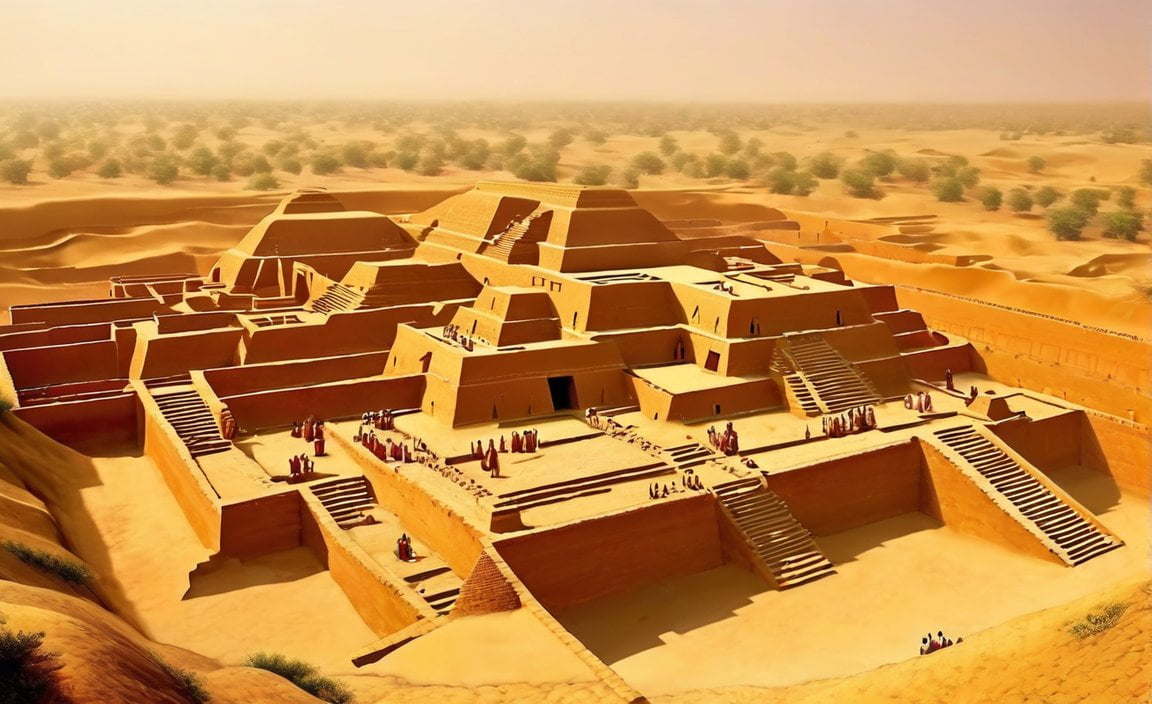
FAQ
Q1: What is the significance of the Indus Valley Civilization?
A1: The Indus Valley Civilization is one of the oldest civilizations in human history and emerged around the same time as ancient Egypt and the early Sumerian cities of Mesopotamia. It showcases advanced architecture, urban sanitation systems, and agricultural development, providing valuable insights into the cultural and social aspects of ancient societies.
Q2: How did the Indus Valley Civilization achieve advanced architecture?
A2: The Harappans exhibited advanced architecture in their cities by constructing dockyards, granaries, warehouses, brick platforms, and defensive walls. These structures not only showcased their craftsmanship skills but also served as protection for the cities.
Q3: What is known about the decline and end of the Indus Valley Civilization?
A3: The Indus Valley Civilization started declining between 1900 and 1500 BCE. The exact reasons for its fall are not fully understood but climate change is believed to have played a role. The civilization’s decline resulted in the end of its cities and marks a significant transition in the history of the region.
Q4: How did the Indus Valley Civilization practice agriculture and sustain their cities?
A4: The Indus Valley Civilization relied on flood-supported farming, where they harnessed the floods of the Indus River and its tributaries. This farming technique provided large agricultural surpluses, which supported the development of their cities and contributed to their economic stability.
Q5: What were the trade and economic activities of the Indus Valley Civilization?
A5: The Indus Valley Civilization had a diverse economy based on agriculture, animal husbandry, and trade. They grew crops such as wheat, barley, peas, and mustard, while domesticating animals like cows, buffaloes, goats, and pigs. They engaged in trade through the barter system, exchanging goods like wheat, peas, dye, and jewelry for gold, copper, turquoise, and more. The civilization also had a highly developed craft and industry sector.
